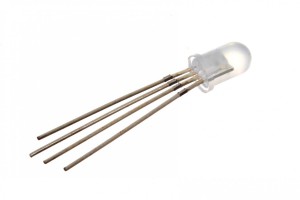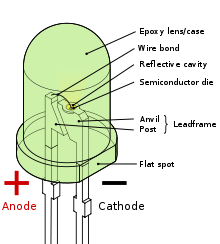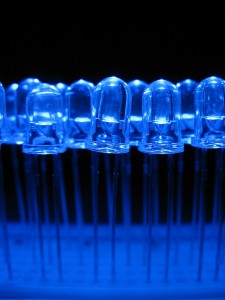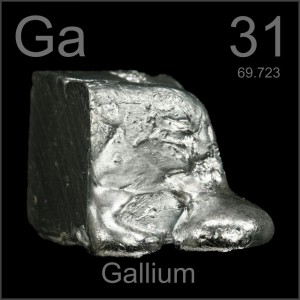This week the posts are focusing a lot on actuators, in technology I’ve noticed that the secret is consistency. There’s too much going on in the field, and it’s very easy to loose focus. I don’t think anyone here is not familiar with LED lights, there pretty much everywhere, and on any electric or electronic device out there. But what are they, besides the easy definition of Light Emitting Diode?
 LED’s are solid-state devices that control current without heated filaments. The common white LED uses 3.6 of DC current and about 30 milliAmps, with a dissipation power around 100 milliWatts (mW). Positive power goes to one side of the LED semiconductor via the anode and the whisker, and the negative power is connected to the top of the anvil or negative power lead (cathode).
LED’s are solid-state devices that control current without heated filaments. The common white LED uses 3.6 of DC current and about 30 milliAmps, with a dissipation power around 100 milliWatts (mW). Positive power goes to one side of the LED semiconductor via the anode and the whisker, and the negative power is connected to the top of the anvil or negative power lead (cathode).
 The chemical composition of the LED semiconductor determines the color of the light it produces and its intensity. The epoxy made enclosure lets most of the light out from the elements, making the LED almost indestructible. And since light-emitting diode don’t have moving parts, they’re extremely resistant to damage due to vibration and shocks. LED’s are invulnerable to failure when operated within design capacity. LED’s are highly resistant to heat, with upwards of 200K per watt. LED’s are highly monochromatic, only emitting a single pure color in a narrow frequency. The peak wavelength (lpk) determines the color emitted from an LED, which is measured in nanometers (nm).
The chemical composition of the LED semiconductor determines the color of the light it produces and its intensity. The epoxy made enclosure lets most of the light out from the elements, making the LED almost indestructible. And since light-emitting diode don’t have moving parts, they’re extremely resistant to damage due to vibration and shocks. LED’s are invulnerable to failure when operated within design capacity. LED’s are highly resistant to heat, with upwards of 200K per watt. LED’s are highly monochromatic, only emitting a single pure color in a narrow frequency. The peak wavelength (lpk) determines the color emitted from an LED, which is measured in nanometers (nm).
There are many materials used in manufacturing LED lights. Most common material used is Gallium-based crystals, used for high-brightness applications. Gallium, a minor metal has a low melting point of 29.8 degrees Celsius. Among the alloys used is AlGaAs (Aluminum-Gallium-Arsenide), a semiconductor that generates the red spectrum. InGaAlP(Indium-Gallium-Aluminum-Phosphide) produces yellow-green wavelength to red, used in signs, auto interior and exterior, traffic signals, and cell-phones. InGaN(Indium-Gallium-Nitride) generates Blue, Green, and white spectrums, used in full color signs, cell-phones, auto interior, and traffic signals.
Light Emitting Diodes are the cutting edge of lighting technology today. LED’s are categorized according to performance. The performance of an LED is associated to the color, peak wavelength, and intensity of the LED itself. Terms such as “super-bright,” and “ultra-bright” used to describe LED intensity is not in any way connected to the brightness of the LED. This is a mere marketing strategy, there’s no established industry standard for LED brightness. This is proportional to the amount of current going through the LED. The greater the current, the higher the intensity of the LED. Luminous intensity does not represent the total light output of an LED. The luminous intensity, and the viewing angle determine this value. The greater the viewing angle, the higher the light output.
 New developments in LED’s are the Flexible OLED displays, made of Using light-emitting organic materials, creating beautiful and efficient displays. There still under R&D, but are soon to be available for the general public.
New developments in LED’s are the Flexible OLED displays, made of Using light-emitting organic materials, creating beautiful and efficient displays. There still under R&D, but are soon to be available for the general public.
LED’s are solid-state devices with no moving parts as well as no fragile glass or filaments. LED’s too use up to 90% less energy in comparison with conventional bulbs and lamps. LED flashlights may last up to 200% longer with the same batteries used to operate conventional flashlights. LED’s are environmentally safe, they contain no mercury and last longer; over 100,000 continuous hours of life, with less waste disposal in the environment. This results in less pollution and less waste of resources.






I think your research has yielded some very interesting results. During my days in high school, I tried to put on a light show using LED Lights but it did not go as well as planned. Never did I think I would encounter the subject of LED’s as part of a class in my life, but I am excited nevertheless.
I personally believe we should have already had a big push to bring LED’s from the commercial side of the spectrum to the convenience of the home. They produce nearly the same results as light bulbs but cost a tenth of the price. However, I think one day if this technology becomes even more affordable, the products we buy could cost substantially less. We could help businesses, including small ones grow whilst allowing a much wider audience to participate in the technology boom of the 21st century.
There are simply so many uses for LED’s nowadays and maybe one day everyone can make new inventions using LED Lights as a power source. It would really open up the field for the amount and types of uses for LED’s. We can make cars in which the headlights can have LED Lights as a light source or lightsaber’s that are powered by LED Lights. Who knows, in the future, entire cities could be powered by LED Lights, which would definitely lower electricity bills (if Con-Ed doesn’t put a stop to that idea).
I found a couple of videos that discuss some uses for LED Lights and how to code them. I hope it helps to shed some light and give more information about what you want to do for your project.